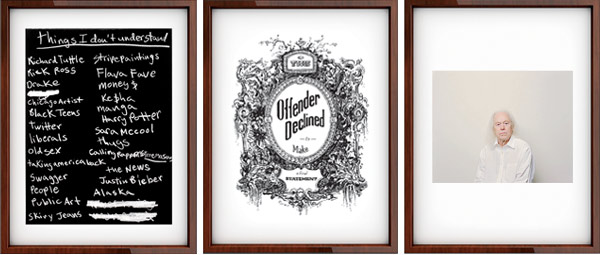
From left: Works by David Leggett and Carol Jackson (available now) and by Jason Lazarus (offered last spring)
Last spring, the West Loop art organization Threewalls began an experiment: What if it introduced art shares—akin to farm shares but with paintings and sculptures in place of tomatoes and kale? The program would help fund Threewalls’ artist residencies and public salons and make the art-buying process less scary. And it would give Chicagoans the chance to purchase original work by the local rising stars Jason Lazarus and Jessica Labatte—upward of $1,000 in a traditional gallery—for $66 apiece.
Loosely modeled on similar efforts in Minneapolis and the Bay Area, the trial run of 100 shares all but sold out by its first delivery, leading the group to plan a streamlined second edition for December. It’s a move that—for artists and buyers on a budget, as well as for the nonprofit Threewalls—could be compared to opening a produce stand in the middle of a food desert.
The winter edition tweaks last spring’s formula, with fewer artists producing fewer works for a smaller fee. Thirty-one shares will be available, with a subscriber paying $310 to receive one work sight unseen by each of four local artists: Brandon Alvendia, Stephanie Brooks, Carol Jackson, and David Leggett. (Though we wrangled a peek at two winter offerings, the surprise element is meant to be part of the fun—so, no, you can’t go online and see exactly what you’ll get if you sign up.) While the spring artists were given no parameters—“We were like, ‘Go crazy. Make 50 pieces and bring them here,’” says Abigail Satinsky, program director for the eight-year-old Threewalls—the winter artists received a simple prompt: Incorporate text.
Satinsky and Threewalls’ cofounder Shannon Stratton jointly select the artists—a curatorial approach that alleviates some of the risk in purchasing art blindly. Even so, the program isn’t without flaws. Artists make very little: Each participant receives a $1,000 stipend, which averages out to just $20 per work last spring, $32 this winter. While past artists cite the chance to reach new audiences as a major plus, Satinsky isn’t sure whether the program has attracted any of its targeted first-time collectors, though tastemakers such as the spring subscribers Stephanie Smith of the Smart Museum and Tricia Van Eck, formerly of the Museum of Contemporary Art, are certainly welcome. (It requires some familiarity with the market to know what a deal Threewalls’ share is.)
The artists we spoke with didn’t seem concerned by the kinks. “It’s really exciting to see an organization try to use innovative ways to raise money,” says Lazarus, whose photography was included in last spring’s share. “This program sets up a more approachable attitude toward collecting, it invests in young artists, and the artists get paid up front.”
Satinsky says she is committed to the art-share model for the next few years; as word gets out, more novice collectors may test the waters. In the meantime, Threewalls is helping launch an even more affordable initiative. At the Jane Addams Hull-House Museum’s new lending library, planned for early winter, Chicagoans can take home artwork for a month at a time from a collection of 30 pieces and counting, including those from Threewalls’ art share. The cost? Free.
GO A winter share is $310 at three-walls.org; $50 more buys a ticket to a party on Dec. 10, featuring edible art by the artist and chef Eric May. Sold out? Your next chance to reserve a share will be February; artists to be determined.
Artwork: (from left) David Leggett, Untitled, 2011; Carol Jackson, This Offender, 2011; Jason Lazarus, Eric Becklin, First Human to See the Center of Our Galaxy


